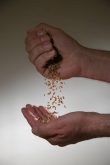Plant breeders around the globe can freely access plant gene banks for development of new crop varieties under the Treaty on Plant Genetic Resources for Food and Agriculture.
Proposed changes at the international level could make access — and future crop research — more costly.
Why it matters: Access to diverse germplasm is valued by crop scientists worldwide. Proposals to charge fees or subscriptions for gene bank access has potential to hobble crop development.
Read Also

The forced Japanese-Canadian farmers of the Second World War
Manitoba’s sugar beet farms drew on displaced Japanese-Canadians from B.C. during the Second World War
Who would pay that cost is not yet known, though some suspect the burden would likely fall on the budgets of research programs and ultimately farmers.
The treaty was designed and implemented to support crop breeding and food security around the world, says Axel Diederichsen. He’s the research scientist and curator for Plant Gene Resources of Canada, the federal body responsible for the protection, preservation and enhancement of all genetics relating to Canada’s important cultivated plants and wild relatives.
Some 151 countries have signed and ratified the treaty, which allows research scientists to access and share the genetic resources of agricultural crops across national borders.
Canada signed and ratified it in 2002. From 2002 to 2023, Plant Gene Resources of Canada has shipped 150,387 seed samples to researchers and breeders in 71 countries.
Diederichsen says the ability to share and access such genetic resources has been invaluable to national and global crop development, agricultural resilience and food security.
“The treaty creates a global pool of genetic resources that are in the public domain of the member countries. It is very important for food security. We are interdependent. Therefore, the intent is to ensure these genetic resources can be shared internationally in a transparent and consistent way.”
Proposed changes
The treaty addresses two components: non-monetary benefits and monetary benefits. Non-monetary benefits include knowledge exchange and other information sharing. Monetary benefits take the form of voluntary donations from treaty member countries to support agriculture projects and advances in less developed parts of the world.
Some countries, such as Norway, have made significant contributions. Others have not. Canada, for example, has only donated about $4,000 to the treaty development fund since 2008.
In 2013, some member countries, non-governmental organizations and others under the United Nations Food and Agriculture Organization began proposing an end to any free-of-charge use of gene banks by crop breeders. The idea was that a fee-for-use system would enhance monetary benefit-sharing.
Some suggest access fees be applied to those who want genetic material from the gene banks of treaty-signatory countries, and mandatory fees for commercialization of new crop cultivars that are based on that genetic material.
A different framework is also being considered under the Convention on Biological Diversity, where products developed from Digital Sequence Information (DSI) – genome sequence data – of a given plant may trigger kickback payments to the country from which that plant came.
Information or material?
Stuart Smyth, associate professor and chair of Agri-Food Innovation and Sustainability Enhancement at the University of Saskatchewan, says the Convention on Biological Diversity payment framework originates from recognition that biodiverse parts of the world, such as the Amazon rainforest, have greatly contributed to the creation of some products, such as cosmetics and pharmaceuticals.
These products are worth billions of dollars, but the region has not received anything in return. DSI is designed to generate a pool of funds that can be shared with communities that made the valuable product possible.
Smyth says applying DSI to the treaty could be an albatross around the neck of crop breeding worldwide.
“All of this is being negotiated at an international level by lawyers. There’s a limited awareness of the importance of sharing germplasm globally for a variety of crop breeding,” says Smyth.
“Any breeder can simply use CRISPR to modify the gene to be a replicate of what they found in an online database… What’s being considered is looking at all these plant genome sequences as knowledge. We say no, it’s data. You need to figure out how to use it to make it valuable.”
Diederichsen believes the issue boils down to whether genetic information is just that — information — or whether it’s material in itself.
“We have to walk a very fine line when it comes to DSI,” he says.
“We have maintained that, yes, we realize there is an issue regarding the DSI that genetic information can result in profits. But we maintain it is not in the scope of the Treaty on Plant Genetic Resources.
“DSI is information only. This is different from material. That’s a given. There is no payment obligation for information. We may create a system which meets these payment expectations, but we cannot say that its obligatory benefit-sharing for the use of information.”
Who pays?
How fees, royalties or other payments will be levied at those accessing gene bank information has not been decided. Assuming a fee-for-access framework is adopted, it’s unknown who will ultimately bear the costs.
“It will have to come from somewhere. Whether it’s the general taxpayer, certain sectors of the economy — I can’t say. It is too early to tell,” says Diederichsen.
His best guess is that payments will be owed by plant breeders and other entities that actually access the gene banks.
Those costs might be prohibitive or may be manageable and it’s not unreasonable to assume those costs will be passed on to farmers. Diederichsen also worries gene banks themselves could be lost.
“Farmers understand how important varieties are to them. Farmers understand how important genetic diversity is. I think they are supportive we don’t lose this genetic diversity. If we have additional payment obligations, we have to make sure its still attractive to use our collections,” he says.
“If people don’t use our collections, which maintain a lot of unique diversity, they are at risk. Will taxpayers pay for things no one uses? That could be a big issue. We may lose material we have preserved for the future.
“We must make sure it remains attractive to access and utilize because this also contributes to food security and the diversification of agriculture.”
Smyth says making breeders pay to access gene sequence data, regardless of whether there is any monetary outcome, would be yet another strain on research dollars.
“It’s going to lower the funding for research. Then the question is, again, who pays? Is it going to be Agriculture Canada? The crop development centre? The seed companies? In agriculture, most things get passed on to farmers,” Smyth says.
“There might also be an issue where some Indigenous communities don’t recognize property rights on plants.
“How do you have benefit sharing? How do you have conversations with Indigenous groups when they don’t recognize the ability to have ownership of that?”















